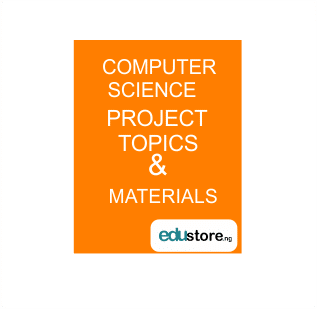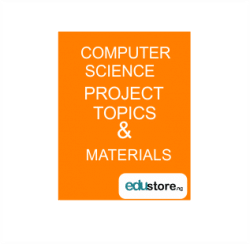computer science project topics and materials for final year students in BSC, OND, HND, MSC & PHD
Mathematics Tutoring Application for Secondary School Student
TABLE OF CONTENTS
TITLE PAGE
CERTIFICATION
DEDICATION
ACKNOWLEDGEMENT
ABSTRACT
TABLE OF CONTENTS
LIST OF TABLES
LIST OF FIGURES
CHAPTER ONE:
INTRODUCTION
1.1 BACKGROUND TO THE STUDY
1.2 STATEMENT OF PROBLEMS
1.3 AIM AND OBJECTIVES OF THE STUDY
1.4 METHODOLOGY
1.5 SIGNIFICANCE OF THE STUDY
1.6 SCOPE OF THE STUDY
1.7 LIMITATION OF THE STUDY
1.8 DEFINITION OF TERMS
CHAPTER TWO:
LITERATURE REVIEW
2.0 INTRODUCTION
2.1 COMPUTER ALGEBRA SYSTEMS
2.2 COMMON MATHEMATICAL SOFTWARE’S
2.2.1 MAPLE
2.2.2 MATHEMATICAL
2.3 MATHEMATICAL APPLICATIONS AND TEACHERS
2.4 WHERE MATHEMATICAL SOFTWARE STAND IN EDUCATION
2.5 TYPES OF TUTORING
2.5.1 PRIVATE TUTORS
2.5.2 ACADEMIC COACHING
2.5.3 STUDENT-TO-STUDENT TUTORING
2.5.4 ONLINE TUTORING
2.5.5 HOME TUTORING
2.6 HISTORY OF GODSAVES SCHOOLS
2.7 ORGANOGRAM OF GODSAVES SCHOOLS
CHAPTER THREE
RESEARCH METHODOLOGY
3.0 INTRODUCTION
3.1 ANALYSIS OF THE EXISTING SYSTEM
3.2 OVERVIEW OF THE PROPOSED SYSTEM
3.3 METHOD OF DATA COLLECTION
3.4 SYSTEM DESIGN
3.4.1 HIPO DIAGRAM (HIERARCHICAL INPUT OUTPUT PROCESSING)
3.4.2: FLOWCHART
3.4.2 USED CASE DIAGRAM
3.5 DATABASE STRUCTURE
3.5.1 INPUT STRUCTURE
3.5.2 OUTPUT STRUCTURE
CHAPTER FOUR:
SYSTEM TESTING AND IMPLEMENTATION
4.0 INTRODUCTION
4.1 CHOICE OF PROGRAMMING LANGUAGE AND DATABASE
4.2 SYSTEM REQUIREMENT
4.2.1 SOFTWARE REQUIREMENT AND SPECIFICATION
4.2.2 HARDWARE REQUIREMENT AND SPECIFICATION
4.3 RESULT INTERFACE
4.4 SYSTEM TESTING AND IMPLEMENTATION
4.5 DESCRIPTION OF FINDINGS
4.6 SYSTEM DOCUMENTATION AND MAINTENANCE
4.6.1 HOW TO LOAD THE SOFTWARE
4.6.2 THE PLATFORM
4.6.3 HOW TO RUN THE SOFTWARE
CHAPTER FIVE:
SUMMARY, CONCLUSION AND RECOMMENDATION
5.1 SUMMARY
5.2 CONCLUSION
5.3 REC0MMENDATION
REFERENCES
APPENDICES
ABSTRACT
This research work deals with mathematics tutoring application for secondary school students. Chapter one is an introduction to the project to describe what the project entails. It discusses the problems in the existing system. Also described in chapter one are the aim, the objectives, the significance and the limitation of the study.
Chapter two is the literature review of the project which contain diverse research and scholarly articles written of this project while chapter three describes the method of data collection, system analysis and design and improvement on the proposed system.
Chapter four describes the implementation and result of the project and lastly, chapter five gives the summary, conclusion and recommendation.
CHAPTER ONE
INTRODUCTION
1.1 BACKGROUND TO THE STUDY
Tutoring application has only been available in recent times and few working in mathematics education today would be unaware of the growth in recent years of computer technologies for teaching, learning and research in mathematics. Calculating technology in mathematics has evolved from four function calculators to scientific calculators to graphing calculators and now to computers with computer algebra software. The use of mathematical library or mathematical software in schools is still rare and since it is difficult for teachers to go beyond the prescribed textbook, the school public library teachings may leave gaps and doubts.
As school activities expands, there have been a lot of task facing the teacher of a class. These tasks (Bertemes, 2016) include taking attendance of the students, teaching the students their class works, among others, hence the need for a tutoring application. A tutoring application that serves as a teaching assistant for the teacher is an application where books are kept, electronically in form of PDFs, Texts or Docs or any readable formats, where videos are stored, source of reference for related courses and mini-dictionary where technical words are stored for easy access and assess. It is a repository of knowledge, houses collections of books, videos and educational games (in form of quiz) and the likes.
Consequently, truth and knowledge can be found and acquired from the application through the aforementioned sources. The information contents (Jo, 2016) of any of collections can be recorded on microfilms, audiotapes, microchips and other materials traditionally kept in a library, which is charged with the responsibility of acquiring, organizing, maintaining, and judicial circulation of the books and other academic materials through the various sections of the application, for efficient use by the users.
1.2 STATEMENT OF PROBLEMS
The need for a mathematical tutoring application in God saves schools is because of the school operates a single non-computerized library system. Based on this, a number of problems face the existence and operation of the computerized mathematical library systems and the students being limited to their school textbooks alone for source of knowledge. Hence, the need for a separate mathematical library and making it, computerized, where the tutoring application can be easily integrated.
1.3 AIM AND OBJECTIVES OF THE STUDY
The aim of the system is to design a tutoring application for secondary schools using God saves schools as a case study.
In this study therefore, the researchers hope to accomplish the following objectives:
- To solve the problem of limiting students to teachings of their teachers in the classroom.
- To create a readily available mathematical dictionary where students can get meaning of mathematical terms
- To create a readily available module that contains a list of some mathematical formulas.
- Provision of readily available tutorials in form of reading materials.
- To design a system that will have a question and answer session at end of each topic to test the knowledge of the student.
1.4 METHODOLOGY
In this research work, Microsoft Visual C# and Microsoft Office Access are used as design methodologies. This is because of their basic advantage over other models or methods; which is their simplicity in nature.
1.5 SIGNIFICANCE OF THE STUDY
This study, tutoring application for secondary school students is designed to bring efficiency in the mathematical library system operations and to provide access to students in getting almost all they need for studies. It will eliminate some of the problems of students being limited to the teachings they get from teachers and textbooks, thereby widening their source of getting information for reading and tutoring materials.
1.6 SCOPE OF THE STUDY
This project looks into the processes involved in keeping tracks of the readable materials. The software will be divided into modules containing selected mathematical topics (indices, surds, completing the square, factorization and quadratic formula), mathematical dictionary containing 300 mathematical terms, a list of mathematical 250 mathematical formulae, which are grouped into 3 different sections and an assessment after each lesson.
1.7 LIMITATION OF THE STUDY
This study will not look in detail of all topics done in secondary school. It will be limited to five selected mathematics topics, which include Indices, Surds, Factorization, Quadratic Formulae and Completing the Square, respectively.
1.8 DEFINITION OF TERMS
Design: It is a detail plan or arrangement to achieve a particular purpose.
System: It is an assemblage of interrelated elements, which we find interesting to study. It could be a process, a machine or a program.
Program: A set of instructions and procedures tells the computer what to do.
Application: A program designed to perform particular tasks.
Tutoring: Is an act or the process of giving instruction or teaching.
User: The user here refers to the people who make use of the application.
Automation/Computerization: It is a process of making a system to carry out its processes on its own without much helps from man.
Module: An independent unit that is part of a larger development. It is the same thing as sub-tasks.
DOWNLOAD COMPLETE WORK NOW
Finding difficulty with codes?
Save time and spend less
HIRE A DEVELOPER TO GET THIS PROJECT’S IMPLEMENTATION (SOURCE CODES) HERE>>
DOWNLOAD COMPLETE WORK- For Reference Only: Materials are for research, citation, and idea generation purposes and not for submission as your original final year project work.
- Avoid Plagiarism: Do not copy or submit this content as your own project. Doing so may result in academic consequences.
- Use as a Framework: This complete project research material should guide the development of your own final year project work.
- Academic Access: This platform is designed to reduce the stress of visiting school libraries by providing easy access to research materials.
- Institutional Support: Tertiary institutions encourage the review of previous academic works such as journals and theses.
- Open Education: The site is maintained through paid subscriptions to continue offering open access educational resources.






